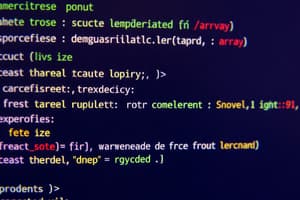Podcast
Questions and Answers
In the context of the provided code, elucidate the potential ramifications of employing a dynamically allocated array in lieu of the statically allocated students array, particularly considering memory management overhead and the prevention of memory leaks.
In the context of the provided code, elucidate the potential ramifications of employing a dynamically allocated array in lieu of the statically allocated students array, particularly considering memory management overhead and the prevention of memory leaks.
Dynamic allocation offers flexibility in array size but introduces complexity in memory management. Failure to free() the allocated memory results in memory leaks. While static allocation fixes the size, it avoids manual memory management.
Formulate a scenario wherein the strcmp function, as utilized within the login() function, could be vulnerable to a timing attack, and delineate a potential mitigation strategy to ameliorate this vulnerability.
Formulate a scenario wherein the strcmp function, as utilized within the login() function, could be vulnerable to a timing attack, and delineate a potential mitigation strategy to ameliorate this vulnerability.
A timing attack exploits the fact that strcmp returns faster when the first characters differ. An attacker can time the responses to guess the password character by character. Mitigation involves using a constant-time comparison function.
Given that the addStudent() function utilizes scanf for input, expound upon the potential security vulnerabilities inherent in this approach, and propose a more robust alternative input method to mitigate these vulnerabilities.
Given that the addStudent() function utilizes scanf for input, expound upon the potential security vulnerabilities inherent in this approach, and propose a more robust alternative input method to mitigate these vulnerabilities.
scanf is susceptible to buffer overflows if the input exceeds the buffer size. A safer alternative is using fgets to read the input into a buffer, followed by parsing the buffer using sscanf.
Critically assess the design choice of using a global variable for studentCount, delineating the potential concurrency issues that could arise in a multithreaded environment, and propose a synchronization mechanism to ensure thread safety.
Critically assess the design choice of using a global variable for studentCount, delineating the potential concurrency issues that could arise in a multithreaded environment, and propose a synchronization mechanism to ensure thread safety.
Elaborate on the potential implications of not validating the input grade within the addStudent() function, considering the impact on data integrity and the generation of meaningful statistical analyses.
Elaborate on the potential implications of not validating the input grade within the addStudent() function, considering the impact on data integrity and the generation of meaningful statistical analyses.
Analyze the inherent limitations of the provided code’s student management system concerning scalability, particularly when dealing with a large number of students (e.g., exceeding the maxStudents limit), and propose an architectural modification to address these limitations.
Analyze the inherent limitations of the provided code’s student management system concerning scalability, particularly when dealing with a large number of students (e.g., exceeding the maxStudents limit), and propose an architectural modification to address these limitations.
Deconstruct the potential consequences of omitting error handling when reading data from the standard input using scanf within the addStudent() function, and devise a strategy to gracefully handle erroneous input scenarios.
Deconstruct the potential consequences of omitting error handling when reading data from the standard input using scanf within the addStudent() function, and devise a strategy to gracefully handle erroneous input scenarios.
Given the current implementation of the displayStudents() function, postulate the performance bottleneck that would manifest when displaying a very large number of students, and suggest an optimization technique to enhance display performance.
Given the current implementation of the displayStudents() function, postulate the performance bottleneck that would manifest when displaying a very large number of students, and suggest an optimization technique to enhance display performance.
In the event of a program crash, diagnose the potential challenges in debugging the provided code, particularly regarding memory corruption issues, and outline a debugging methodology to effectively identify and rectify such issues.
In the event of a program crash, diagnose the potential challenges in debugging the provided code, particularly regarding memory corruption issues, and outline a debugging methodology to effectively identify and rectify such issues.
Assess the security implications of storing the password in plaintext within the login() function, and propose a more secure alternative for storing and verifying user credentials.
Assess the security implications of storing the password in plaintext within the login() function, and propose a more secure alternative for storing and verifying user credentials.
Devise a comprehensive testing strategy to rigorously validate the functionality and robustness of the student management system, encompassing both unit tests and integration tests, and specify the key test cases to be included.
Devise a comprehensive testing strategy to rigorously validate the functionality and robustness of the student management system, encompassing both unit tests and integration tests, and specify the key test cases to be included.
Illustrate a refactoring approach to modularize the provided procedural code into an object-oriented design, outlining the classes, methods, and relationships that would comprise the refactored system.
Illustrate a refactoring approach to modularize the provided procedural code into an object-oriented design, outlining the classes, methods, and relationships that would comprise the refactored system.
Formulate an augmentation to the Student structure that incorporates dynamic memory allocation for the name field, addressing the limitations imposed by the fixed-size character array, and delineate the corresponding memory management responsibilities.
Formulate an augmentation to the Student structure that incorporates dynamic memory allocation for the name field, addressing the limitations imposed by the fixed-size character array, and delineate the corresponding memory management responsibilities.
Elaborate on the potential advantages and disadvantages of employing a hash table data structure, as opposed to the existing array, for storing and retrieving student records based on their unique IDs.
Elaborate on the potential advantages and disadvantages of employing a hash table data structure, as opposed to the existing array, for storing and retrieving student records based on their unique IDs.
Critically evaluate the design decision of implementing the main menu loop using a do...while construct, considering its impact on code readability and maintainability, and propose an alternative looping structure that enhances these aspects.
Critically evaluate the design decision of implementing the main menu loop using a do...while construct, considering its impact on code readability and maintainability, and propose an alternative looping structure that enhances these aspects.
Given that the program interacts with the user through the console, investigate the feasibility of developing a graphical user interface (GUI) for the student management system, and delineate the key considerations and challenges associated with such a transition.
Given that the program interacts with the user through the console, investigate the feasibility of developing a graphical user interface (GUI) for the student management system, and delineate the key considerations and challenges associated with such a transition.
Formulate a scheme to integrate persistent data storage into the student management system, enabling the preservation of student data across program executions, and delineate the trade-offs associated with different storage formats (e.g., plain text files, CSV files, databases).
Formulate a scheme to integrate persistent data storage into the student management system, enabling the preservation of student data across program executions, and delineate the trade-offs associated with different storage formats (e.g., plain text files, CSV files, databases).
Deconstruct the potential vulnerabilities associated with directly utilizing user-supplied input (e.g., student names) in constructing dynamic SQL queries, and propose a secure alternative to prevent SQL injection attacks.
Deconstruct the potential vulnerabilities associated with directly utilizing user-supplied input (e.g., student names) in constructing dynamic SQL queries, and propose a secure alternative to prevent SQL injection attacks.
Devise an exception handling strategy to gracefully manage runtime errors that may occur during program execution, such as file I/O errors or memory allocation failures, ensuring that the program does not terminate abruptly.
Devise an exception handling strategy to gracefully manage runtime errors that may occur during program execution, such as file I/O errors or memory allocation failures, ensuring that the program does not terminate abruptly.
Assess the impact of compiler optimizations on the performance and security of the provided code, delineating scenarios where specific optimizations (e.g., loop unrolling, inlining) may introduce unintended vulnerabilities or side effects.
Assess the impact of compiler optimizations on the performance and security of the provided code, delineating scenarios where specific optimizations (e.g., loop unrolling, inlining) may introduce unintended vulnerabilities or side effects.
Formulate a mechanism to implement access control within the student management system, enabling different user roles (e.g., administrator, teacher, student) with varying levels of permissions and access privileges.
Formulate a mechanism to implement access control within the student management system, enabling different user roles (e.g., administrator, teacher, student) with varying levels of permissions and access privileges.
Illustrate the implications of employing a garbage-collected language, in contrast to C, for implementing the student management system, particularly concerning memory management overhead and the potential for nondeterministic behavior.
Illustrate the implications of employing a garbage-collected language, in contrast to C, for implementing the student management system, particularly concerning memory management overhead and the potential for nondeterministic behavior.
Propose a solution to enhance the maintainability and understandability of the code through the strategic application of design patterns (e.g., Factory, Singleton, Observer), specifying the patterns and the rationale for their selection.
Propose a solution to enhance the maintainability and understandability of the code through the strategic application of design patterns (e.g., Factory, Singleton, Observer), specifying the patterns and the rationale for their selection.
Given the potential for concurrent access to student records in a multi-user environment, devise a locking strategy, beyond mutexes, to ensure data consistency and prevent race conditions, while minimizing the impact on performance and scalability.
Given the potential for concurrent access to student records in a multi-user environment, devise a locking strategy, beyond mutexes, to ensure data consistency and prevent race conditions, while minimizing the impact on performance and scalability.
Analyze the challenges presented by internationalizing the student management system, particularly with respect to handling different character encodings, date formats, and localization of user interface elements.
Analyze the challenges presented by internationalizing the student management system, particularly with respect to handling different character encodings, date formats, and localization of user interface elements.
Flashcards
#include and #include
#include and #include
Libraries for using built-in functions in C. stdio.h handles input/output (printf, scanf), and string.h provides string functions (strcmp).
struct Student
struct Student
A structure that groups related data (id, name, grade) together for a single student.
students
students
An array that stores multiple Student structures, holding up to 50 students.
int studentCount
int studentCount
Signup and view all the flashcards
int maxStudents
int maxStudents
Signup and view all the flashcards
int login()
int login()
Signup and view all the flashcards
void menu()
void menu()
Signup and view all the flashcards
void addStudent()
void addStudent()
Signup and view all the flashcards
void displayStudents()
void displayStudents()
Signup and view all the flashcards
Function declaration
Function declaration
Signup and view all the flashcards
Study Notes
#include <stdio.h>and#include <string.h>are libraries providing built-in functions.stdio.his used for input/output operations likeprintfandscanf.string.his used for string manipulation functions likestrcmp.
Struct Student
- Structures group related data under a single name.
- The
Studentstruct stores an integerid, a charactername, and a floatgradefor each student. - Serves as a template for student records.
Students Array
struct Student students;declares an array ofStudentstructures.- Stores up to 50 students, with each element holding a
Studentstruct.
Student Count
int studentCount = 0;tracks the number of students added.- Used to determine the correct position for adding new students.
Max Students
int maxStudents = 50;defines the maximum number of students the system can store.- Used to ensure there is space before adding a new student.
Login Function
int login()function prompts for a username and password.- Returns 1 (true) if the username is "admin" and the password is "1234", otherwise returns 0 (false).
- Prevents unauthorized access and demonstrates a function with a return value.
Menu Function
void menu()presents a menu of options to the user.- A loop continues until the user chooses to exit (choice == 3).
- Calls other functions based on the user's input.
Add Student Function
void addStudent()adds a new student to the array.- Checks for available space in the array before adding a student.
- Takes input for
id,name, andgrade. scanf(" %[^\n]",...)reads the full name with spaces.
Display Students Function
void displayStudents()shows all the students added so far.- Loops through the array to print each student's information.
Function Declarations
- A function declaration informs the compiler of a function's name, return type, and parameters.
- Allows the program to call a function before its complete code is encountered.
- Example declarations:
int login();- Name:
login - Returns:
int(1 for success, 0 for failure) - Parameters: none
- Asks the user to enter a username and password.
- Declared as
intbecause it returns 1 if login is successful and 0 if it fails.
- Name:
void addStudent();- Name:
addStudent - Returns:
void(no return value) - Parameters: none
- Adds a student to the array.
- Return type is
voidas it performs an action without needing to return a value.
- Name:
void displayStudents();- Same as above, returns nothing and prints all students in the array.
void menu();- Shows the main menu and executes other functions based on user input.
- Controls the program's flow, allowing the user to select actions.
Function Structure
- A function has three key parts:
- Declaration:
int login();- Notifies the compiler of the function's name and return type. - Definition:
int login() { ... }- Contains the complete code describing what the function does. - Call:
login();- Instructs the program to execute the function.
- Declaration:
- Functions should be declared before
main()to prevent compiler errors when calling them inmain().
Studying That Suits You
Use AI to generate personalized quizzes and flashcards to suit your learning preferences.




